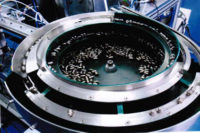Clean room manufacturing process required a stainless steel vibratory bowl.

Crown Automated Feeders Inc. built the bowl. Because the bowl would be handling a medical device, it was constructed to Food and Drug Administration specifications. The bowl was built from 316 stainless steel, so it could be cleaned, says Peter Wagner, vice president of Crown Automated Feeders. All seams were double-welded and double-polished to eliminate any crevices that could provide a home to bacteria.
The primary challenge was to achieve the high feed rate without any jams. Tooling engineers were able to use the hub’s natural bottom-heaviness to their advantage to separate and correctly orient the parts. “We have toolers with 20 years of experience,” says Wagner. “They were able to apply knowledge from past applications to this one.”
In the end, the bowl provided an average feed rate of 520 parts per minute. For more information, call 905-648-8975 or visitwww.crownfeeders.com.
Editor’s note: “We Fed It” is a regular series profiling parts feeders for automated assembly. Whether it’s a vibratory bowl, a tray feeder or a flexible robotic system, if you’ve solved a parts-feeding challenge, we’d like to hear about it. Send an e-mail to John Sprovieri, editor of ASSEMBLY, at sprovierij@bnpmedia.com, or call 630-694-4012.





